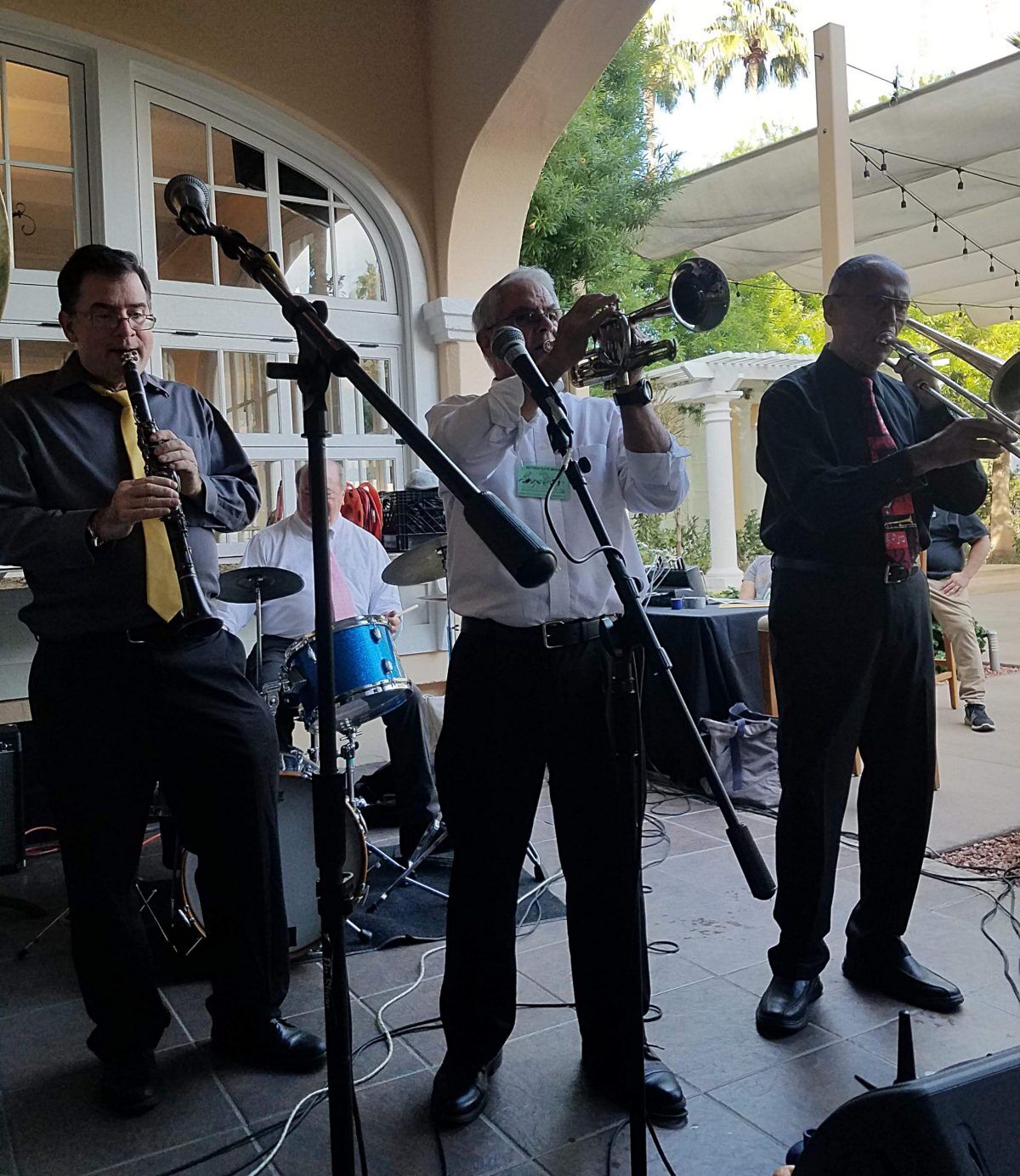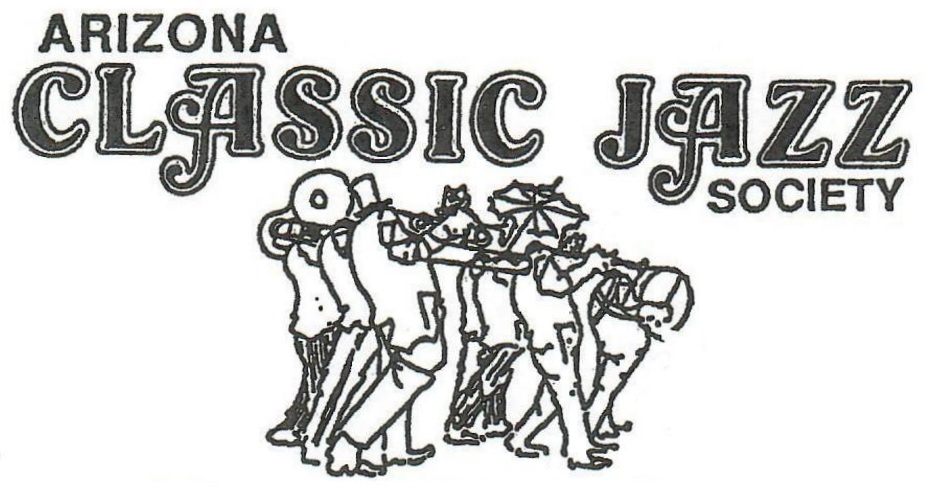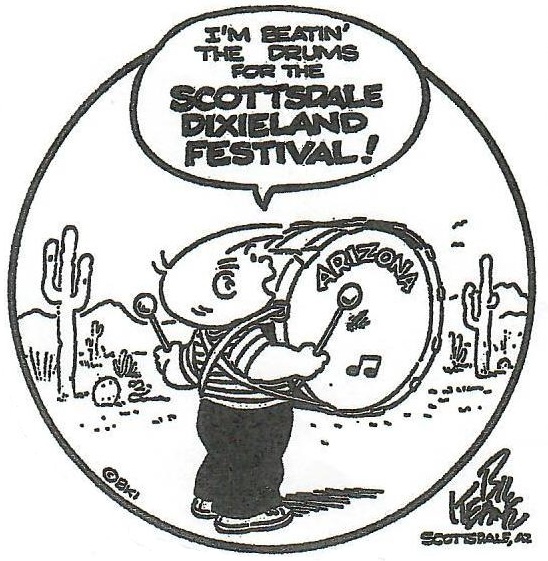Citing a diminishing population of traditional jazz fans and declining attendance, Society president and Festival director Helen Daley released a statement that the upcoming Arizona Classic Jazz Festival (Oct. 31-Nov. 3) would be the last festival in a 35-year run, and that the Arizona Classic Jazz Society, which was organized in 1984, would hold its final concert-meeting on December 1, 2024.
Authorized by the ACJS board of directors, the statement read: “There is a song entitled ‘All Good Things (Come to an End.)’ It is not a happy tune. I have to tell you now that the Arizona Classic Jazz Society/Festival will no longer exist after the end of this year, 2024. We’ve had a good run; many people say ours is the best Festival on the jazz circuit. We have experienced that music tastes change with the times and everything cycles. The Evaluation comments from the 2023 Festival suggested we offer more country music. However, that would defeat our original purpose of promoting and perpetuating classic jazz.
“Festival attendance is down from year to year, and badge prices have never paid for the Festival. If not for our wonderful sponsors and cosponsors, we would have had to close many years ago. The State of Arizona has cut the Arizona Commission on the Arts budget by 60%. Grant recipients received notice that any grant amounts would be greatly reduced or eliminated for 2025. This year’s award was $11,500.

“An angel rescued the Society’s Sunday programs this year. It costs more than $2,000 a month to keep the Society afloat, and we feel fortunate when we take in $500 on Sundays. The last Sunday event will take place on December 1, 2024. The school programs will continue for another two years.
“We do not have a young Board of Directors, and there are no new, willing volunteers. Half of the Board are in their 80s, with two close to 90 years old. Four members gave notice that this would be their last year serving; leaving the Board with four less than the required minimum of eight members. Based on increasing challenges, it was decided by a majority vote that Festival Year 35 was a good stopping point and that we should close at the end of 2024 while we can still cover all our expenses.”
Society Founded in 1984
It was in 1984 that a group of Dixieland afficionados would regularly congregate at a Scottsdale hotel for the Sunday sessions of the Desert City Six and Big Tiny Little. It wasn’t long before the idea of organizing a jazz society came up, and the Scottsdale Dixieland Jazz Society became a reality. Dues were $10 for individuals and $15 for couples. Later that year, the fledging society hired a bus to transport 50 members to the Thanksgiving festival in San Diego to see how a festival was run. (As an interesting sidebar, $160 covered the bus fare, hotel room, all-events badge, a t-shirt, Society charter membership and tips!)
The Society got its feet wet in running a jazz festival in April 1985 with the one-day Desert Dixieland Jamboree in Phoenix. The following February, an out-of-town promoter came to town to put on what was to be the first annual Arizona Traditional Jazz Festival with 10 bands and six individual performers at the Rawhide Western Town in North Scottsdale. The weekend event was a success, but the following Monday found a group of unhappy musicians when they weren’t able to deposit or cash their performance checks.
As membership grew to 1,000 in just a few short years, the Society achieved non-profit status in 1989, held monthly meetings, published a quarterly newsletter, and promoted education through presentations at school assemblies and instruction to small youth groups.
1st Festival Drew 2,200
The Society was back in charge in November 1990 with the first annual Scottsdale Dixieland Jazz Festival at the Sunburst Resort (now The Scott Resort & Spa) with a Veterans Day weekend attendance of 2,200. The Night Blooming Jazzmen, Natural Gas, and South Market Street were brought in to draw from three major California cities, with six local bands completing the lineup.
The next year saw a 67% increase in attendance to nearly 4,000 fans. Since then, the Festival has been held at eight different properties in four cities in the Phoenix metropolitan area, and the name changed when it moved out of Scottsdale in 1998. The Festival last relocated to Chandler in 2004 to take advantage of the larger venues at the Crowne Plaza San Marcos Golf Resort.
 Family Circus cartoonist Bil Keane, bandleader Frankie Carle, and U.S. Senator Barry Goldwater were honorary chairmen in the Festival’s early years. Fourteen individuals have served as Festival directors or co-directors, with current honcho Helen Daley having the longest tenure of over 20 years. (She inherited a $20,000 deficit, which was liquidated in a few years.)
Family Circus cartoonist Bil Keane, bandleader Frankie Carle, and U.S. Senator Barry Goldwater were honorary chairmen in the Festival’s early years. Fourteen individuals have served as Festival directors or co-directors, with current honcho Helen Daley having the longest tenure of over 20 years. (She inherited a $20,000 deficit, which was liquidated in a few years.)
On the 20th anniversary of the Festival in 2009, it was estimated that 105 bands had been hired over the previous two decades, involving 600 musicians performing 1,781 sets and 1,860 hours of jazz, which costed out at $2.47 per hour “to hear some of the best traditional jazz in the land.” (That 2024 number would be a little over $6 an hour.)
History of Jazz Festivals
The Newport Jazz Festival in Rhode Island bills itself as “the granddaddy of all festivals. Tobacco heiress Elaine Lorillard is credited with establishing the festival, initially held at the Newport Casino in 1954. She hired promoter George Wein to be the producer, a role in which he continued in some capacity for over 60 years. Performing before 13,000 fans, the initial lineup included Ella Fitzgerald, Billie Holiday, Sir George Shearing, and Eddie Condon, with Stan Kenton as MC. The Festival moved to Freebody Park in 1955 and currently is held at Fort Adams State Park.
Following World War II, a number of New Orleans musicians moved to Los Angeles in search of work (primarily in the movie and recording studios) and brought their styles of Dixieland jazz with them. In his well-researched JAZZ WEST book, K.O. Eckland documented that the Dixieland Jubilee headlined by the Louis Armstrong All-Stars was held on October 5, 1948 at the Pan-Pacific Auditorium in Los Angeles as “the very first showcase of Traditional Jazz.”
A Dixieland at Disneyland festival was held for 10 years at Anaheim, Calif. (1962-71), and soon volunteer-run societies were holding festivals in Los Angeles, San Francisco, Pismo Beach, San Diego, Santa Rosa and Friday Harbor, Washington. The first Sacramento Dixieland Jazz Jubilee came into being in 1974, and it was not long before the Memorial Day weekend event was attracting 100,000 fans, filling local hotel rooms and having a $200 million economic impact on community businesses.
Jazz Parties vs Festivals
The Jazz Party format was introduced by businessman Dick Gibson in Colorado in 1963. How does a Jazz Party differ from a Jazz Festival? To a large degree, it’s mainly in the logistics. Jazz Parties are usually held in a hotel ballroom where 12 to 20 all-star musicians hold forth over a weekend performing in different mix-and-match combinations. As one Jazz Party director explained, “A Jazz Party is smaller with more intimate interplay between the fans and musicians. These world-class musicians may never have played together before, but you would never know it when they get to do what they do best.”
Jazz Festivals are normally produced by a local Jazz Society on an annual basis that have a number of organized bands playing in various locations, some of which may be temporary or outdoors, that require shuttles to transport fans to the various venues. For the first Arizona festival, a ballroom, two smaller meeting rooms and a tent set up next to the Hotel pool provided four venues. At Sacramento, multiple venues were located in various sections of the city, including Downtown Sacramento, Old Town and the Cal Expo fairgrounds.
However configured, the number of these events has greatly diminished, but we’ve had a great 40-year run.
Lew Shaw started writing about music as the publicist for the famous Berkshire Music Barn in the 1960s. He joined the West Coast Rag in 1989 and has been a guiding light to this paper through the two name changes since then as we grew to become The Syncopated Times. 47 of his profiles of today's top musicians are collected in Jazz Beat: Notes on Classic Jazz.Volume two, Jazz Beat Encore: More Notes on Classic Jazz contains 43 more! Lew taps his extensive network of connections and friends throughout the traditional jazz world to bring us his Jazz Jottings column every month.






















